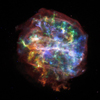CXC Home | Search | Help | Image Use Policy | Latest Images | Privacy | Accessibility | Glossary | Q&A
Animation of Supernova Explosion
Quicktime MPEG
This artist's animation shows the basics of a supernova explosion like the one that created the Kepler supernova remnant. When a massive star runs out of fuel, it collapses onto itself and its remains are then expelled into the surrounding space. This expanding debris field is very hot and thus glows brightly in X-rays, which are detected by telescopes like Chandra. The shape of the remnant produced by this kind of supernova - known as Type Ia - is more symmetrical than remnants created the collapse of a massive star.
[Runtime: 00:15]
Quicktime MPEG
This artist's animation shows the basics of a supernova explosion like the one that created the Kepler supernova remnant. When a massive star runs out of fuel, it collapses onto itself and its remains are then expelled into the surrounding space. This expanding debris field is very hot and thus glows brightly in X-rays, which are detected by telescopes like Chandra. The shape of the remnant produced by this kind of supernova - known as Type Ia - is more symmetrical than remnants created the collapse of a massive star.
[Runtime: 00:15]
(Animation: NASA/CXC/A.Hobart)
Comparison of Chandra Images of Supernova Remnants
Quicktime MPEG
This sequence shows examples of the two different categories of supernova remnants identified in the latest Chandra study. The first, a remnant known as G292.0+1.8, represents a type of supernova where a massive star collapses on itself. The shape of this type of remnant is relatively asymmetric. The second object is known as the Kepler supernova remnant. A thermonuclear explosion on a white dwarf produced this remnant and others like it, which are much more symmetrical in shape than G292 and its brethren.
[Runtime: 00:30]
Quicktime MPEG
This sequence shows examples of the two different categories of supernova remnants identified in the latest Chandra study. The first, a remnant known as G292.0+1.8, represents a type of supernova where a massive star collapses on itself. The shape of this type of remnant is relatively asymmetric. The second object is known as the Kepler supernova remnant. A thermonuclear explosion on a white dwarf produced this remnant and others like it, which are much more symmetrical in shape than G292 and its brethren.
[Runtime: 00:30]
(Credit: NASA/CXC/UCSC/L. Lopez et al.)
Return to G292.0+1.8 & Kepler's Supernova Remnant (December 17, 2009)




